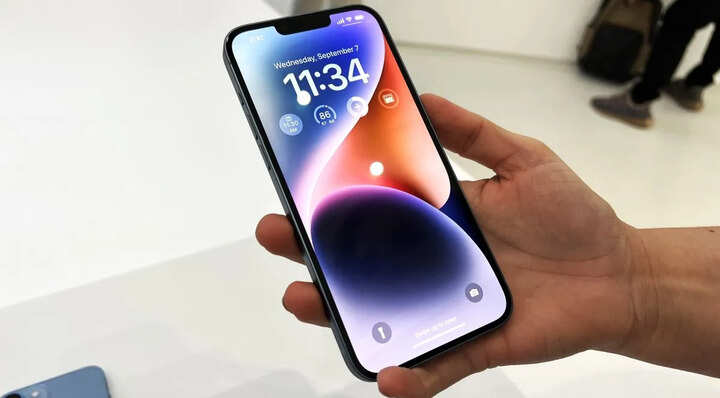How to enable iMessage Contact Key Verification on your iPhone running iOS 17.2
In pic: iPhone. Representative Image
Apple has introduced a new security feature, Contact Key Verification (CKV), with the release of iOS 17.2, adding an extra layer of assurance to your iMessage conversations. This feature alerts you if unrecognised device keys are detected, offering increased confidence in your messaging interactions.
Contact Key Verification in iOS 17.2
Contact Key Verification provides automatic alerts when iMessage key distribution services identify unverified device keys, such as those from an unfamiliar device added to your iMessage account. This extra security measure is especially valuable when used in person, during FaceTime calls, or through other secure methods. While rare, this feature demonstrates Apple’s commitment to staying ahead of potential threats and ensuring user peace of mind.
Notably, enabling CKV does not compromise the functionality of your iPhone or iMessage, making it a user-friendly security enhancement.
Read Also


How to enable Contact Key Verification in iMessage app:
Before you start
Ensure that all devices signed into your iCloud account are running iOS 17.2, macOS 14.2, or watchOS 10.2. If not, consider signing out of iMessage on devices where you don’t want to enable the feature.
- On your iPhone running iOS 17.2, open the Settings app.
- Tap on your name at the top of the screen.
- Swipe down to the bottom and select “Contact Key Verification.”
- Toggle the switch next to “Verification in iMessage” to enable CKV.
- Follow the on-screen prompts to complete the activation process.
Using Contact Key Verification
Once activated, CKV offers several functionalities:
- Automatic Alerts: Receive alerts that help verify you are communicating with intended contacts.
- Unique Codes: Generate and compare unique codes with your contacts in the Messages app for additional identity verification.
- Public Verification Code: Share your Public Verification Code on social media to allow others to confirm your identity when messaging you. Similarly, save others’ codes in the Contacts app for reference.
Note: CKV focuses on preventing sophisticated cyberattacks and does not guard against fraud, such as phishing or text-based scams. For more information and troubleshooting tips, consult the Apple Support article on iMessage Contact Key Verification.
Conclusion
Use this feature responsibly, and remember that if someone shares a Public Verification Code with you, ensure it matches the one on their social media profile before continuing communication. This adds an extra layer of security to your iMessage interactions, protecting you from potential threats.
FacebookTwitterLinkedin
end of article

In pic: iPhone. Representative Image
Apple has introduced a new security feature, Contact Key Verification (CKV), with the release of iOS 17.2, adding an extra layer of assurance to your iMessage conversations. This feature alerts you if unrecognised device keys are detected, offering increased confidence in your messaging interactions.
Contact Key Verification in iOS 17.2
Contact Key Verification provides automatic alerts when iMessage key distribution services identify unverified device keys, such as those from an unfamiliar device added to your iMessage account. This extra security measure is especially valuable when used in person, during FaceTime calls, or through other secure methods. While rare, this feature demonstrates Apple’s commitment to staying ahead of potential threats and ensuring user peace of mind.
Notably, enabling CKV does not compromise the functionality of your iPhone or iMessage, making it a user-friendly security enhancement.
Read Also


How to enable Contact Key Verification in iMessage app:
Before you start
Ensure that all devices signed into your iCloud account are running iOS 17.2, macOS 14.2, or watchOS 10.2. If not, consider signing out of iMessage on devices where you don’t want to enable the feature.
- On your iPhone running iOS 17.2, open the Settings app.
- Tap on your name at the top of the screen.
- Swipe down to the bottom and select “Contact Key Verification.”
- Toggle the switch next to “Verification in iMessage” to enable CKV.
- Follow the on-screen prompts to complete the activation process.
Using Contact Key Verification
Once activated, CKV offers several functionalities:
- Automatic Alerts: Receive alerts that help verify you are communicating with intended contacts.
- Unique Codes: Generate and compare unique codes with your contacts in the Messages app for additional identity verification.
- Public Verification Code: Share your Public Verification Code on social media to allow others to confirm your identity when messaging you. Similarly, save others’ codes in the Contacts app for reference.
Note: CKV focuses on preventing sophisticated cyberattacks and does not guard against fraud, such as phishing or text-based scams. For more information and troubleshooting tips, consult the Apple Support article on iMessage Contact Key Verification.
Conclusion
Use this feature responsibly, and remember that if someone shares a Public Verification Code with you, ensure it matches the one on their social media profile before continuing communication. This adds an extra layer of security to your iMessage interactions, protecting you from potential threats.
FacebookTwitterLinkedin
end of article
